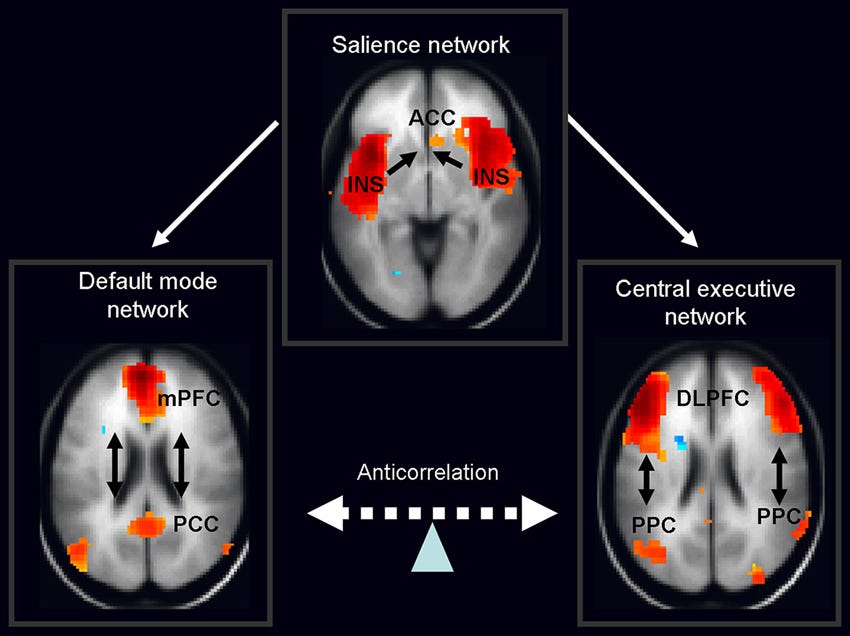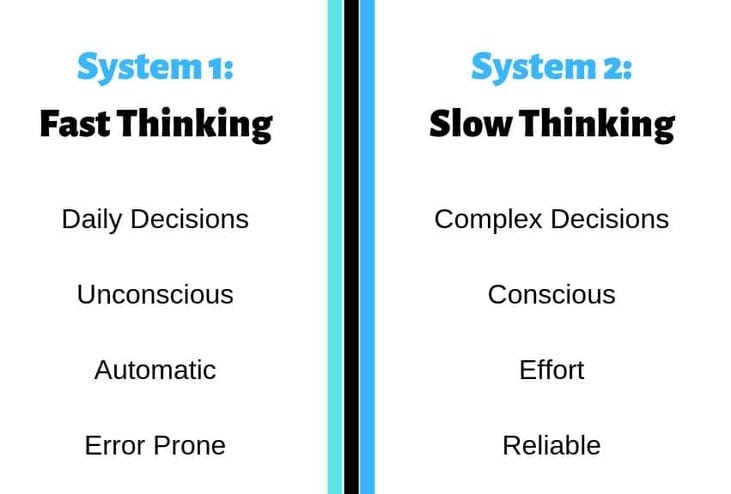I have long been interested in two different subjects that seem obviously related: the structure of the brain and personality differences.
Brain Structure
First, I want to provide a brief overview of different models of how the brain is structured. This is all very oversimplified, but if you think I get any of the basic ideas wrong, please comment!
Brain Hemispheres
This probably isn’t news to you, but the brain has two sides that can operate more or less independently. One side basically controls one side of the body, but they cooperate to form our consciousness.
There are several good books based on brain hemispheres that have influenced my thinking. The first was The Origin of Consciousness in the Breakdown of the Bicameral Mind, a classic in where Julian Jaynes argues that until the late Bronze Age collapse people used to hear voices (which they interpreted as angels and gods) generated by the right hemisphere, and then this broke down and interactions between left/right hemisphere difference became central to a new model of a sense of self.
I don’t buy the whole theory in all its details, but I think it is correct in some important points. The hemispheres can operate more or less independently, and their interaction is central to our consciousness. It’s really mind blowing — definitely recommend.
Another great book about hemispheric differences is The Master and His Emissary, where Iain McGilchrist argues that the right hemisphere really makes all the decisions and the left hemisphere just rationalizes/verbalizes them. Again, you don’t have to believe all the details, but I think it is directionally correct, and related to Jaynes’ argument. Specifically, Jaynes believed ancients used to believe that they really had no choice but to obey the voices they heard.
Triple Network Model
The next model of the brain I want to introduce is the Triple Network Model (TNM). As the name suggests, it includes three networks of brain regions: he default mode network (DMN), salience network (SN) and executive control network (ECN) also known as the central executive network (CEN).
A few basics about the TNM:
The DMN processes thoughts that occur when we aren’t focused on anything
The ECN controls focused thoughts and behaviors
The SN helps switch between the other two based on stimulus
A bunch of MRI studies have tested what kinds of tasks/thoughts involve DMN/ECN/SN.
A few things that activate the DMN:
self-assessment
social skills
remembering experiences
language comprehension
inner narrative
A few things that activate ECN:
working memory
information processing
rule-based decision making
considering different factors
making choices
The Triple Network model doesn’t show up as much in popular literature because it’s so new (the DMN was discovered about 20 years ago), but I wouldn’t be surprised the next Master and His Emissary will focus on it.
Also note that the DMN and ECN are both divided into front (pre-frontal cortex/PFC) and back (posterior cingulate cortex/PCC) regions as well as top (dorsal) and bottom (ventral) regions. The PFC region of the DMN is probably central to social processing.
Network Connectivity
In addition to the hemispheric and triple network models is the concept of local vs. global connectivity. Basically, regions can develop more connections within regions (and hemispheres) and between regions (and hemispheres).
As explained here, local connections are associated with the development of more specific abilities, and global connections are associated with more general ability (i.e., abilities that draw on many specific functions).
The Chemical Brain
The third physical model of the brain I want to mention has more to do with the chemistry of the brain than its physical structure. One model focuses on four hormonal systems: dopamine, serotonin, testosterone, and estrogen/oxytocin system. here are some of the effects these hormones have on the brain:”
Dopamine
increases stimulus-seeking/curiosity
increases energy
Serotonin
balances mood
increases caution/compliance
Testosterone
increases aggression
increases analytic activity
Estrogen/Oxytocin
increases empathy
increases social sensitivity
Personality
Now I want to introduce four different personality models and discuss how they are related to different brain structures. The four models are masculine/feminine, autistic/schizophrenic, the big five model, and a four factor model based on the four hormonal systems.
Gender Differences
So much has been written about the differences between men and women. A few traits associated with each include:
Masculine
aggressive
analytical
stable
risk-seeking
Feminine
empathetic
emotional
volatile
risk-averse
Maybe you have your own list that is different from these. Please share! But the bottom line is that men and women have some personality differences, and these differences are rooted in their brains.
So what are the differences in male and female brains?
Hemispheres
Men tend to have more connections within brain hemispheres, whereas women tend to have more connections between hemispheres. In fact, the connectivity picture from above is from an article highlighting gender differences.
Triple Network Model
Men tend to have more activity/development in the ECN, whereas women tend to have more activity/development in the SN/DMN
Connectivity
Generally, men tend to have more local connections (leading to overall larger brain volume), whereas women tend to have more global connections.
Hormones
Men tend to have higher levels of testosterone, dopamine, and serotonin. Women tend to have higher levels of estrogen and oxytocin.
Autism and Schizophrenia
The now-famous psychologist writing under the name Scott Alexander once wrote an article discussing whether autism and schizophrenia exist on the same spectrum. I think it’s a useful model, but they also share some similarities. There is also an interesting theory called the Extreme Male Brain theory of autism that appears to have some support.
Here are some attributes of each:
Autism
impaired social interaction/theory of mind
preference for routine/sameness
specialized interests
self-stimulation
detail-oriented thinking
Schizophrenia
hallucinations/delusions
disorganized thinking
erratic movement
attention/working memory deficit
depression
People with autism show some different brain structures.
Hemispheres
People with schizophrenia show reduced hemispheric dominance. People with autism show reduced hemispheric specialization.
Triple Network Model
Autism and schizophrenia are both associated with impaired network coordination. Schizophrenia is associated with hyperactivity in the DMN.
Connectivity
People with autism sometimes have increased local connectivity, which can be associated with higher brain volume.
Hormones
Prenatal exposure to testosterone may be a cause of autism. People with autism have reduced oxytocin. Schizophrenia is associated with dopamine imbalance (too much in some areas, too little in other areas).
The Big Five Model
The big five model of personality is probably the most well-tested personality model. It divides personality traits into 5 categories: Extroversion, Openness, Conscientiousness, Neuroticism, Agreeableness. Big Five personality traits can be predicted fairly well based on brain structure.
Extroversion
This trait refers to how outgoing and assertive a person is. It is associated with left-brain dominance, high dopamine, high testosterone (and estrogen!), and high connectivity in the DMN, and high activity in the PFC (i.e., for social processing).
Openness
This trait refers to novelty-seeking and curiosity. It is associated with right-brain activity, high dopamine, increased ventral DMN activity (associated with vivid imagination), and decreased dorsal DMN activity (associated with evaluating experiences).
Conscientiousness
This trait refers to diligence and orderliness. It is associated with high levels of dopamine and serotonin (i.e., consistent motivation) and high activity in the ECN (i.e., focus). It is negatively associated with hyperactivity in the SN.
Neuroticism
This trait refers to emotional volatility and threat sensitivity. It is associated lower brain volume, increased SN activity, decreased DMN connectivity (the opposite of extraversion), decreased ventral DMN activity, and increased dorsal DMN activity (the opposite of openness). Neuroticism is also associated with lower testosterone (and estrogen!) and reduced cortisol response (i.e., a blunted response to stress).
Agreeableness
This trait refers to empathy and compliance. It is positively associated with high activity in the SN (i.e., the opposite of conscientiousness), high DMN connectivity (similar to extraversion), and high levels of serotonin.
Here is a chart showing some of the connections (admittedly a major oversimplification, but should be in more or less the right direction)
:
Four Factor Model
I recently came across another model of personality similar to the Big Five, but explicitly connected to the different hormonal systems. The four categories are:
Curious/Energetic (dopamine)
Cautious/Social Norm Compliant (serotonin)
Analytical/Tough-minded (testosterone)
Prosocial/Empathetic (estrogen)
There is a lot more research related to the Big Five, but I kind of like this model because you can kind of collapse it further into two primary dimensions: high risk/low risk and social/analytical. Then you could make a political quadrant chart based on personality:
Models of Thinking
There are a number of other models of the brain that fit somewhere in between models of the brain and models of personality. The most prominent among these is the Freudian/Jungian model of conscious/subconscious and id/ego/superego. Here is a diagram from Jung.
If I had to make some connections, I would say that the id is related to the limbic system that governs basic drives, the ego is related to the ECN, and the superego is related to the DMN. In the Jungian diagram the self and the persona are probably functions of the DMN, whereas the ego is related to the ECN.
Another famous model is the system 1/system 2 mode from Daniel Kahneman’s book Thinking Fast & Slow.
In this model, system 1 probably involves components of the limbic system, DMN, and other brain areas whereas system 2 is probably related to the ECN.
One final model I want to toss in there is this one from my post on triangle models:
Here the “king” seems connected to the ECN (and Analytical/Tough-minded/Testosterone). The “citizen” corner is connected to the DMN (and to both Prosocial/Empathetic/Estrogen and Cautious/Social Norm Compliant/Serotonin). The “philosopher” is probably related to the ECN as well (Curious/Energetic/Dopamine).













Great post. I hadn't heard of the triple network model. Definitely fascinating, and as you point out it maps pretty well to Kahneman's System 1 and System 2.
Of course as you may know I'm more interested in how these models might end up being ill adapted for a post-internet world where they're constantly in contact with a new gigantic, strange, and artificial brain. McGilchrist's primary argument is that while the right hemisphere should be making the call, the left hemisphere has taken over (though he would date this usurpation to many decades before the internet.) What do other models lead you to believe?
It seems we have one of three possibilities:
1- Modern information technology has improved the brain: Perhaps in some ways, but given that we are adapted to completely different environment, it seems unlikely that we would get a net benefit.
2- Modern infotech does nothing to the brain: Perhaps we're just so resilient that we can take whatever gets throw at us and remain unscathed. Certainly Haidt would disagree with this point, and he does seem to have a pretty good argument.
3- Modern infotech does not play well with the brain and it's messing us up. This is McGilchrist's argument, and Haidt's and many others.
What are your thoughts on which of the three it ends up being, and how the different models you've presented might do a better job of illuminating whether infotech is beneficial or not?
Nice! Let me throw in one more model. I found this extremely helpful, particularly in making sense of some of my default settings https://medium.com/life-tactics/14-tools-for-better-work-and-relationships-from-the-neuroscience-of-emotions-210de40ebebe